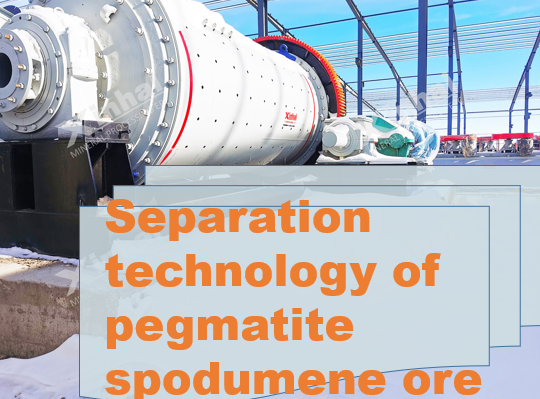Separation technology of pegmatite spodumene ore
2024-08-21 Xinhai (1523)
2024-08-21 Xinhai (1523)
If you have any questions, please contact us through the following ways, we will give you more and better assistance!

As the most important hard rock lithium ore, pegmatite spodumene ore is still an important source of lithium extraction before the development and utilization technology of low-concentration, high magnesium-lithium ratio salt lake lithium ore has made a major breakthrough. For pegmatite lithium ore, according to the type and content of lithium minerals in the ore, it can be subdivided into pegmatite spodumene ore, pegmatite lithium mica-spodumene ore and pegmatite petalite-lepidolite mica ore.
The mineral composition of pegmatite spodumene ore is complex. The main useful mineral is spodumene, and it may also contain a certain amount of tantalite, beryl and cassiterite accessory minerals. The main gangue minerals are silicate minerals such as feldspar, quartz and mica (mainly muscovite).
For pegmatite spodumene ores with tantalum-niobium ores (such as tantalum-niobium iron ore) and cassiterite accessory minerals, the separation process needs to add a process for removing accessory minerals to separate (comprehensively recover) these accessory minerals as by-products. For example, in the separation of Xinjiang Keketuohai pegmatite spodumene ores, a rotating spiral chute is used to separate and recover tantalum-niobium minerals, and spodumene is recovered by flotation of tantalum-niobium gravity separation tailings.

The density of spodumene is 3.1~3.2g/cm3, and the densities of quartz, feldspar and muscovite, the main gangue minerals coexisting with it in pegmatite spodumene ores, are 2.65, 2.60 and 2.80g/cm3 respectively. The density of spodumene is slightly larger than these gangue minerals. Although it is difficult to use spiral chutes and shaking tables and other gravity separation equipment to separate spodumene, for spodumene with coarse crystal size, heavy medium separation can be used to make spodumene a heavy product and gangue minerals a light product, thereby achieving the separation of spodumene and gangue minerals.
Flotation is the most important separation method for spodumene. The flotation of spodumene can be divided into positive flotation process and reverse flotation process. The reverse flotation process uses lime to adjust the slurry, adds dextrin and starch to inhibit spodumene, and uses cationic collectors to reverse float mica, quartz and feldspar. Since the zero charge point (PZC) of these silicate gangue minerals is very close to that of spodumene, the selectivity of cationic collectors adsorbed on the mineral surface by electrostatic action is poor. With the development and breakthrough of spodumene positive flotation process, reverse flotation process has been replaced by positive flotation process and is generally only used for impurity removal of spodumene concentrate.
For positive flotation of spodumene, according to the pH of the flotation slurry, it can be divided into a low alkalinity process with a slurry pH of 7.5~9.5 and a high alkalinity process with a slurry pH greater than 11. The low alkalinity process is suitable for the flotation of pegmatite-type spodumene ores with low mud content. In a low alkaline environment, when fatty acids are used as collectors, the floatability difference between the surface pure spodumene particles and the gangue minerals (quartz and feldspar) is large, and the selective recovery of spodumene can be achieved.
In pegmatite-type spodumene ores, the common iron-containing gangue minerals are tourmaline and amphibole. In the flotation or heavy medium separation of spodumene, these iron-containing gangue minerals are easy to enter the spodumene concentrate product and affect the concentrate quality and product grade. Magnetic separation can be carried out before spodumene flotation to remove a large amount of iron-containing gangue minerals; it can also be carried out after flotation to remove iron impurities in the spodumene flotation concentrate to improve the product grade of the concentrate.